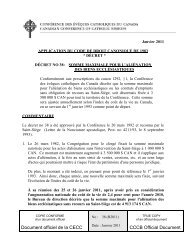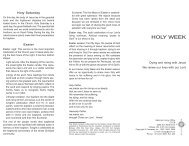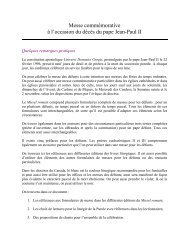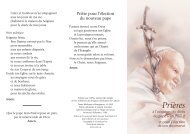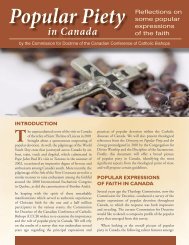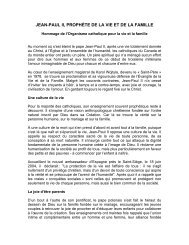LITURGY NEWSLETTER LITURGY NEWSLETTER
LITURGY NEWSLETTER LITURGY NEWSLETTER
LITURGY NEWSLETTER LITURGY NEWSLETTER
You also want an ePaper? Increase the reach of your titles
YUMPU automatically turns print PDFs into web optimized ePapers that Google loves.
<strong>LITURGY</strong> <strong>NEWSLETTER</strong>Vol. 3, No. 3 Spring 2010A quarterly newsletter prepared by the National Liturgy Officeof the Canadian Conference of Catholic BishopsNOT AN ACCESSORYThe last two issues of the Liturgy Newsletter have focused on theneed to revitalize the language of symbol in liturgy, to create strongsymbols that speak loudly even before a word is spoken. This issuecontinues that thread of thought from the perspective of a liturgicalenvironment specialist.Recently I had occasion to read again, the ritual text Dedicationof a Church and an Altar. In the actual Prayer of Dedication, a prayerreplete with rich theological and scriptural images of the church, wefind this reference to Baptism: “Here may the waters of Baptismoverwhelm the shame of sin; here may your people die to sin and liveagain through grace as your children.” I had the privilege of presidingat the Baptism of three beautiful infants. It was truly a joyfulcelebration. It took place during the Sunday Eucharist in awelcoming parish, a parish which has a very strong and healthytradition of good liturgical practice, but I did not experience a senseof Baptism “overwhelming” the shame of sin.Last year (2009), I was invited to be the guest homilist for theTriduum in a parish near Ottawa. At the Easter Vigil, a mother and herthree children were initiated into the Church. The actual Baptism wasdone by means of full immersion, and all the elements of the rite werethere – the full throated acclamation by the assembly after each baptism,the clothing with a full white garment, candles etc., but it was the actionof baptism itself which was unforgettable. No. 206 of the Rite of ChristianInitiation of Adults reads: “Therefore in the celebration of baptism thewashing with water should take on its full importance as the sign thatmystical sharing in Christ’s death and resurrection through which thosewho believe in his name die to sin and rise to eternal life.” On thisoccasion, a retired priest and close friend of the family was standing nextto me. After the actual water baptisms, he said to me in a sincerewhisper “I have performed thousands of baptisms over the years andtonight I have finally experienced the awesomeness of its significance.”Fr. Edward Yarnold, in the preface to his book The Awe-InspiringRites of Initiation says he could just as easily “without beingunfaithful to the Greek” called his book The Spine-Chilling Rites ofInitiation, since the complex of initiatory rituals were “calculated toinspire religious awe and to make these rites the occasion of a lifelongconversion.” In that age of robust liturgy, “people were sosensitive to symbols that the liturgy could be left to speak for itself,even before the preacher had given any explanation.” Perhaps it istime to become re-sensitized to the power of symbol.In This Issue —Articlespage• Not an AccessoryNational Liturgy Office (NLO) 1• Baptismal Fonts and theRenovation of a Church . . . . 2• Baptismal Fonts in the NewChurch Building . . . . . . . . . . . 6General informationsidebarpage• We’re on the web . . . . . . . . . 2• NLO is easy to reach . . . . . . . 2• NLO staff . . . . . . . . . . . . . . . . . 2• To order CCCB products . . . . 2• National Councilfor Liturgical Music members 2• Episcopal Commissionfor Liturgy members . . . . . . . . 3• Consultants . . . . . . . . . . . . . . . 3• National Councilfor Liturgy members . . . . . . . . 3All articles are produced by the NationalLiturgy Office unless indicated: “Usedwith permission.” NLO articles may bereproduced without permission, providedyou do not sell copies, and you properlyacknowledge the source including thewebsite address (see next page). For allother use, please contact the publisher.If you wish to reproduce an articlethat is not produced by the NLO, pleasecontact the copyright holder.Liturgy Newsletter – Fall 2009 1
We’re on the web —Web: http://www.cccb.caThe NLO is easy to reach —Tel: 1-613.241.9461ext. 108 or 154Fax: 1-613.241.9048E-mail: nlo@cccb.caMail: National Liturgy OfficeCanadian Conferenceof Catholic Bishops2500 Don Reid DriveOttawa, ON K1H 2J2CanadaIn the document Our Place of Worship produced by the CanadianConference of Catholic Bishops in 1999 we read the followingparagraph:The General Introduction to the Rite Christian Initiation states thatwhile the water rite may be carried out either by immersion orpouring, immersion is “more suitable as a symbol of participationin the death and resurrection of Christ” (no.22). This suggeststhat the baptismal font be large enough for immersion, both ofadults and children. The Roman Rite has traditionally practicedimmersion (the candidate stands or kneels in water which maybe of various depths) along with affusion (pouring of water overthe candidate’s head and body.).In this Newsletter, Phil Horrigan reflects on baptismal fonts intwo articles – one concerning the renovation of churches and thesecond for the construction of new churches. The font is whereChristians are made. It is far from an accessory.National Liturgy Office staff:• Director: Rev. Bill Burkeliturgy@cccb.ca• Secretary: Jessica Rachednlo@cccb.ca• Typesetting: Michael Ruckpaulmruckpaul@cccb.caTo order CCCB products:Publication Service —Online: www.cccbpublications.caE-mail: publi@cccb.caTel: Canada and the USA1.800.769.1147Tel: Ottawa and area613.241.7538Fax: 613.241.5090National Council for LiturgicalMusic Members:• Msgr. Murray J. KroetschChair• Sr. Donna KellyAtlantic Liturgy Conference• Leslie SteeleWestern Conference for Liturgy• Rev. Geoffrey AngelesWestern Conference for Liturgy• John DawsonOntario Liturgical Conference• Rev. John-Mark MissioOntario Liturgical ConferenceBAPTISMAL FONTSAND THE REONVATION OF A CHURCHPhil HorriganRev. Philip Horrigan, a priest of the archdiocese of Kingston, is a Liturgical DesignConsultant working out of Chicago. He is available for consultation and professionalguidance on a wide variety of issues for parishes planning to build or renovatechurches. The Liturgy website is being renovated and expanded. When that work iscompleted, we will have a section containing the contact information and C.V.’s forprofessionals such as Fr. Horrigan, but in the meantime, if you wish to have moreinformation on him now, you can contact the NLO.There are three primary liturgical centres in the design of aCatholic church: the baptistery, the nave (the area for thecongregation) and the sanctuary. Although these areas are distinctbecause of the ritual actions that are celebrated in each, andbecause of the furnishings that are located within each area, theoverall design and arrangement of a church should not be a seriesof unrelated spaces. The community of faith gathers and celebratesas a single body, united in faith through baptism. The nature of theliturgy demands that the community participate as one body,gathered in a place that serves and enhances its image as the onebody of Christ in praise of the Father. The architectural imperativeof the whole space is one that reflects an integration of design,scale, form, and materials. The integrity of the Church’s worship,as it is expressed in all the many elements of ritual prayer, is bestserved when there is an organic harmony within the architecture.The primary principle for church design is that it serves the ritualactions of the whole liturgical assembly.The renovation of Catholic churches during the years followingthe liturgical reforms of the Constitution on the Sacred Liturgy (1963)has posed a number of challenges for architects, liturgicalconsultants, pastors and parishioners. The most obvious being thatthe churches built prior to the reforms of the Second Vatican Council(1962-65) were designed to accommodate a different liturgicalpractice. Today the nature of liturgy calls for full, conscious and2 National Liturgy Office
active participation on the part of the gathered community, and thisprincipal is a critical consideration for the renovation of any church.It has been said that when it comes to renovating any building toserve a new purpose that what was originally intended, the buildingalways wins. Whether that is an absolute truth is debatable, butthere is some truth in the statement nonetheless. The renovation ofchurches designed in a former liturgical era present both challengesand opportunities for those parishes that want their liturgical spaceto serve well the ritual demands of the liturgy today.This article deals with one of the liturgical areas and itsfurnishings, namely the baptistery and the baptismal font.The importance of the rites of initiation can hardly be over-statedin the liturgical tradition and theology of the Church. Of all thesacraments, it is the first one to have a scriptural reference in the NewTestament, namely the baptism of Jesus recorded in all three of thesynoptic gospels (Mark 1.9-11; Matthew 3.13-17; Luke 3.21-22). Sincethe apostolic era, the Church has welcomed new members into itsmidst through the rites of baptism. Through the centuries, these riteshave changed a number of times, but the immersing in or the pouringof water has been the central action. The place for the celebration ofbaptism changed through the centuries, as has the design and style ofthe baptismal font. (See article in previous edition of this Newsletter).Prior to the restoration of the Rite for Christian Initiation of Adults(RCIA) as demanded by the Constitution on the Sacred Liturgy (1963,see paragraphs 64-66), most churches had pedestal type fonts, sinceinfant baptism was the normative practice. These fonts were designedwith a basin on top of a pedestal. They were located in a number ofdifferent places within the church: in a small baptistery adjacent to thenarthex, in the sanctuary or close to it; in a back corner of the nave; orin a side chapel. Although they were often beautifully designed theyrarely were visible and almost always were empty.Several years before the restoration of the adult catechumen, theliturgy for the Easter Vigil had been reformed (1951-52) and the ritesof initiation were given particular prominence within the celebrationof the Vigil. The pastoral notes for the RCIA expressed the importantconnection between the sacramental theology of baptism and theliturgical practice as expressed in and through the words, actions,gestures and symbols of the rite (see nos. 1-28). Accordingly,parishes desired to provide a more appropriate place for thecelebration of baptism and a more worthy font to express that “thosewho are baptized are united to Christ in a death like his, given newlife and with him rise again to the newness of life” (Romans 6.4-5).When parishes contemplate a renovation of their church, thequestion concerning a more suitable place for baptism is raisedbecause of several factors: the existing font is inadequate, it is apedestal and looks like a temporary piece of furniture (it may even beon castors and often stored out of sight); it is poorly designed andstruggles to look like a worthy liturgical symbol; it is inadequate forthe immersion of infants or adults; it is located in a space that doesnot allow for the gathering of more than a few people; it is in an arearemoved from the main worship space and thus does not allow thewhole assembly to have a sense of participating in the celebration ofthe rites of initiation.Episcopal Commission for LiturgyMembers:• Most ReverendAlbert LeGatt (Chair)Archbishop of Saint-Boniface• Most ReverendRichard GagnonBishop of Victoria• Most ReverendFred ColliBishop of Thunder Bay• Most ReverendDouglas CrosbyBishop of Corner Brookand LabradorConsultants:• Most ReverendTerrence Prendergast, S.J.Archbishop of OttawaVox ClaraNational Council for LiturgyMembers:• Rev. John G. Hibbard (Chair)• Heather ReidElected Representative ofOntario Liturgical Conference• Rev. Greg CoupalElected Representative ofWestern Conference for Liturgy• Rev. Daniel MacLennanElected Representative ofAtlantic Liturgy Conference• Rev. Renato PasinatoAppointed Representative ofWestern Conference for Liturgy• Rev. Jim RichardsAppointed Representative ofAtlantic Liturgy Conference• Sr. Sheila WhelanAppointed Representative ofOntario Liturgical ConferenceLiturgy Newsletter – Spring 2010 3
What to do? This Q&A format is intended to assist parishes withthis discussion.Q. What is a baptistery?A. It is the area where the rites of initiation are celebrated,particularly the rite of baptism. In the early centuries it could be aseparate structure or a separate part of the church joined to themain church by a passage way. The font was located in this area andfor the first few centuries the font was designed to accommodatebaptism by immersion. Over the centuries, with the changes in thebaptismal rite, the baptistery was often located adjacent to thenarthex. Today the baptistery is still the place for the celebration ofbaptism but in many churches this area is less defined and oftenthere is no dedicated place for the celebration of baptism. Morerecent developments in church design have seen the return of adedicated place for the rites of initiation.Q. Where to put the font?See, I am making all things new.(Rev. 21.5 )Thus the three sacraments of Christianinitiation closely combine to bringus, the faithful of Christ, to his fullstature and to enable us to carryout the mission of the entire people ofGod in the church and in theworld.(Christian Initiation,General Introduction no. 2)A. The more important question is, “Where is the best place forthe celebration of the rites of initiation?” It is important to see theplacement of the font as central to the area where the rites ofinitiation can be most suitably celebrated rather than a piece offurniture that has to go some place.In a new church construction it is possible to design thebaptistery near the main entrance area, which is the mostappropriate location. In a renovation project that option may belimited by the amount of space available near the entry. Otherlocations will depend on the arrangement of the nave and whether itis possible to remove some pews in order to provide sufficient roomfor the ritual actions.The font should not be located in the sanctuary. None of theChurch documents concerned with liturgical design mention locatingthe font in the sanctuary. That is the place for those furnishings thatserve the liturgy of word and the liturgy for Eucharist.Q. Why immersion?A. There is ample evidence from archaeological sites and fromhomiletic texts from the early Church that baptism by immersionwas the gesture for baptism. Early textual references frequentlyallude to Pauline theology that speaks of the catechumen “dying andrising” to a new life in Christ. The gesture of immersion was anobvious expression of that theology. The practice of immersion wasessentially lost when the catechumenate “disappeared” around thesixth century. From that time into the twentieth century the baptismof infants and adults was done by pouring water over the head ofthe one being baptized.Although this manner of baptizing is acceptable, it is clear fromcurrent Church documents that immersion is the preferred gesture.The pastoral notes in the Rite for the Christian Initiation of Adults(no. 22) and the Catechism of the Catholic Church (No. 1239) indicatethat the gesture of immersion is more expressive of the fullness ofthe sacrament.4 National Liturgy Office
Q. What are the design issues?A. Baptismal fonts are liturgical items and as such should bedistinguished by their beauty, scale, design and materials. Theoverall design of an immersion font could use one of the traditionaldesigns: hexagonal, octagonal, tomb, or cruciform. The font needs tobe large enough to hold sufficient water for an adult to be able tostand, kneel or bend forward into the water. The usual materials arethose that work well with water: stone, marble or metal. The size,colour and arrangement of tiles used for the interior should becarefully chosen so that they do not give the appearance of adomestic type installation. Because water has a mind of its own, thefewer seams that can be used in the design, the better. The use ofwood for the exterior of the font is rarely a good choice.Q. What are the practical issues?A. Perhaps the most practical issue in a renovation project is tomake sure that the necessary mechanical needs are available;namely access to plumbing and electrical supply. Although thesecan always be made available, sometimes the cost can beprohibitive. However, if the commitment is to provide a worthy placefor the celebration of the sacrament of baptism, then the effort isworth the cost.Q. What are the pastoral issues?A. First, there needs to be a commitment to provide a worthy anddedicated place for the sacrament of baptism. If a suitable locationcan be arranged near the main entry of the church, then the watersof the font become accessible for the faithful as they enter and leavethe church. The opening rites of welcome and sprinkling for thefuneral liturgy also take place at the font. Often there is concern thatthe font be located so that everyone can see the baptism. Althoughthis is a laudable consideration, it is rarely possible no matter wherethe font is located. Usually the font is surrounded by the immediatefamily and the remainder of the assembly does not actually see thegesture of baptizing. It is helpful to remember that participation inthe liturgy is not limited to “seeing.” Other modes of participationinclude hearing the prayers and responding to them, singing duringthe processions to and from the font, and waiting in silentanticipation for the new members to be brought into the midst of theassembly. Also, there is no requirement that the entire rite needs tobe celebrated at the font. The anointings, the profession of faith, thepresentation of the candle and the baptismal garment can take placein the midst of or at the front of the assembly.Father, look now with love uponyour Church and unseal for herthe fountain of baptism.(Blessing of Water A, Rite ofChristian Initiation of Adults)We ask you Father, with your Sonto send the Holy Spirit upon thewaters of this font. May all whoare buried with Christ in the deathof baptism rise also with him tonewness of life.(RCIA – Blessing of Font)Q. What else goes in the baptistery?A. There needs to be a place for the paschal candle and usuallythe blessed oils are placed in an ambry nearby.Q. What other considerations are there?A. Not only should there be a dedicated place for the baptistery,but the font should be fixed in a permanent place within thebaptistery. If the existing pedestal font is a worthy art piece, it couldbe incorporated into the design of a new font.Liturgy Newsletter – Spring 2010 5
BAPTISMAL FONTSIN THE NEW CHURCH BUILDINGSThe baptism of Jesus at the beginning of his public ministry by Johnthe Baptist, is the foundational event for the practice and theology ofthe sacrament of baptism in the Christian tradition.The stories of baptisms in the early Church, as recounted in theActs of the Apostles and in Pauline letters, tell us that this waterritual became the manner of welcome and initiation for those whosought membership in the fledging Christian community. It was Paulwho developed an early theology of baptism, especially in Chapter Sixof his letter to the Romans, that has continued to be the primaryunderstanding in the Church today of this first sacrament.The historical development of the theological nature of baptism,its ritual practices and the changes in that practice, and theevolution of the place and design for fonts, provide a fascinatingstudy of the sacrament — a study that is beyond the scope of thisarticle.This sacrament is called Baptism,after the central rite by which it iscarried out: to baptize (Greekbaptizein) means to “plunge”or “immerse”; the “plunge” intothe water symbolizes the catechumen’sburial into Christ’sdeath, from which he rises up byresurrection with him, as “a newcreation.”(Catechism of theCatholic Church, no.1214).However, the place for baptism, along with the design, scale, andlocation of the font are of particular interest today for those parishesconsidering the construction of a new church.When parishes begin discussions on the design of a new church,a brief review of the history of the place for baptism would beespecially helpful.Liturgical historians and scholars agree that there were specialplaces for baptism prior to the church building initiatives of the earlyfourth century that were due in part to the Peace of Constantine(313). These places were either in nearby streams or located in adomestic type setting, similar to the room in the third century housechurch of Dura-Europus, later to be called “baptisteries.”Liturgical documents from these early centuries indicate thatthere was ample water used, that it was fresh (and probably cold),and that those to be baptized entered the water for the accompanyingrites. (Note: baptism means “to be dipped.”) The use of “living” waterwas significant as it expressed the new life that was poured out uponthe one seeking to enter the life of Christ.(See: Didache, 7; Justin Martyr’s First Apology, 61; and ApostolicTradition of Hippolytus, xxi, 2).Archaeological excavations from these early decades show thatthe design of the fonts varied; some were tomb-like, some in theshape of a hexagon or an octagon, and some were cruciform. Eachshape had a symbolic meaning: the cruciform design reflecting themystery of dying and rising in Christ; the hexagon referring to thesixth day of the week on which Christ died; the octagon meaning theeight day — the day of resurrection; the tomb design, sometimeswith three steps into it, referring to the three days that Christ spentin the tomb.These fonts were large enough for adults to enter them and to bebaptized by immersion. It is conceivable that the catechumens eitherstood or knelt in the water as the bishop or presbyter poured water6 National Liturgy Office
over them. There is reference in the Apostolic Traditions (xxi, 3,11)that the catechumen was naked for the pouring of the water.Although there are some indications that children were baptizedalong with other members of a family household, the baptism ofadults was the normal practice.With the demise of the catechumenate after the sixth century,the practice of baptizing infants became the norm. With thisdevelopment there was a corresponding change in the design, scaleand shape of the baptismal font. Large immersion fonts were nolonger needed and over the course of the Middle Ages the design ofthe font resembled a large chalice, with a bowl on top of a pedestal;frequently a lid was attached to prevent the water from being stolen.Eventually the water disappeared altogether, though these pedestalfonts continued to have covers on them which is a design featurethat still exists in some churches today.During this time the location of the font also changed. The largebaptisteries of earlier decades were no longer needed and the fontmoved inside the main church, sometimes in the narthex or in asmall baptistery adjacent to the main entry. In later centuries thefont was placed either near or in the sanctuary to provide moreconvenient access for the priest or deacon who baptized. In somecases the font was placed on a set of casters so that it could bemoved to any location in the church; and when it was not in use itwas stored out of the way. This was one of the more regrettabledevelopments in church design!As a result of these later developments a number of conclusionscan be made:~ The loss of the catechumenate affected not only the theology ofbaptism, but the design and location of the font.~ The place for the celebration of the rites of initiation becameless and less important in the overall design of the church andthus the importance of the sacrament itself in the life of thecommunity was diminished.Since the beginning of the world,water, so humble and wonderful acreature, has been the source oflife and fruitfulness.Sacred Scripturesees it as “overshadowed” by theSpirit of God: At the very dawn ofcreation your Spirit breathed onthe waters making them thewellspring of all holiness.(Catechism of theCatholic Church, no. 1218).~ The font became more of a furnishing and the baptistery wasno longer a liturgical center or a dedicated space for thecelebration of the sacrament.~ The removal of water from the font meant that the primaryliturgical symbol of the sacrament was no longer visible oraccessible to the community. Hence the introduction of smallfonts or stupes attached to the walls near the doors of thechurch for the gesture of blessing; a gesture that was to be areminder of baptism.~ The rites associated with celebration of baptism were“condensed” and minimalized since the baptism of infantsbecame the norm. The Rite for the Baptism of Infants becamethe normative rite and was used for adults with only minorchanges in the words.~ The participation of the faithful (apart from the immediatefamily) was lost and the relationship between baptism andLiturgy Newsletter – Spring 2010 7
Eucharist was forgotten, at least in the ritual practice and inthe church design, even though it still existed in theologicalprinciple.Since it is through the sacrament of baptism that Christiansenter the Paschal Mystery of Jesus Christ and are named andanointed as children of the God, and since all the other sacramentsflow from the grace and identity that is poured out at baptism, it is ofcritical importance that the place of baptism, the baptistery have asignificant location within the footprint of the church design.The following points need to be considered:See where you are baptized, seewhere Baptism comes from, if notfrom the cross of Christ, from hisdeath. There is the whole mystery:he died for you. In him you areredeemed, in him you are saved.(Catechism of theCatholic Church, no.1225,citing St. Ambrose, De Sac.).1.The most important question Where is the best place for thecelebration of the rites of initiation? This is a ritual questionand the answer can be found in an understanding of the ritualimportance of the font within the liturgical celebrations of theChurch. If the question is only, “Where can we put the font?”then the answer is less likely to be suitable. In one sense, thefont can go anywhere; but that’s been part of the problem inour history and was solved with a set of wheels so it couldmove about the space. The ritual issue has to do with theparticipation of the assembly in the rites of initiation, in thefuneral rites and in the gesture of blessing as people enter andleave the church. The baptistery is a liturgical centre, as is thesanctuary, and is more than a site for the font.2.The location of the baptistery The sacrament of baptism hasbeen referred to as the “threshold” of our faith journey. Withthat in mind, it is most appropriate that the baptistery belocated near the entry of the church. The baptistery is really aplace of transition. The faithful move through this area tocelebrate Eucharist; the funeral procession pauses here as thebody is sprinkled in the opening rites of the funeral liturgy;people encounter the font as they enter and leave the church.It is a place of memory and mission for through the gesture ofblessing we remember who we are as we gather as the Churchand are dismissed into the mission of the gospel.The baptistery is intended to be a dedicated space; it is notpart of the gathering area or of the main aisle. It is the placefor the font, the paschal candle and usually an ambry. It is anample space, suitable for the rites of baptism both for infantsand adults. The use of architectural detail can give this space adefinitive character; for example, recessed lighting, an archthat gives the sense of portal, a change in the floor materialwith an inlay pattern, as well as some appropriate art piecesthat reflect the rich imagery associated with biblical references.If possible the chapel of reconciliation should be located closeto the baptistery, thus making the connection between thesacrament of reconciliation that returns us to the fullness ofour baptismal commitment. In the early history of the Church,the sacrament of reconciliation was called “second baptism.”3.The font The design of the font should have some connectionto the theological and liturgical traditions of the sacrament.8 National Liturgy Office
The font is not a garden sculpture or a vessel that might lookmore at home in a shopping mall display. Although it is aliturgical item, it is both functional and symbolic. As afunctional piece it needs to hold a generous amount of water. Itneeds to be large enough to allow for the immersion of adults.The plumbing system needs to work well, allowing for thecirculation and heating of the water, easy maintenance andaccessibility to the mechanical parts.The symbolic nature of the font relates to the use of “living”water, i.e. it should be moving water, though it need not be awaterfall; the materials should speak of it being a liturgicalappointment, well crafted and beautiful; the design shouldreflect a shape that is identifiable with the traditional designs:octagon, hexagon, cruciform, round, or tomb-like. Somecontemporary font designs have attempted to reflect a “womblike”style thus echoing the new birth that is celebrated in thesacrament. In all cases the design and scale of the font needsto avoid being too lavish or ornamental such that it detractsform its liturgical purpose.4.Elements of design As with many liturgical furnishings, thereare no exact details required for their design. There isn’t anydirection about how much water is needed for an immersionfont. It is helpful to look for “clues” in the ritual texts and inthe theology of the sacrament. In the Rite for the Dedication ofa Church and an Altar, the dedicatory prayer includes thisphrase, “here may the waters of baptism overwhelm the shameof sin.” Perhaps it is helpful to ask, what does “overwhelm”look like as a way to determine how much water is needed.Certainly the sacrament of baptism, as with all the sacraments,celebrates the abundant grace of Jesus Christ; and since wateris the principal sign of that abundance in the sacrament ofbaptism, then what amount of water best signifies suchabundance. The understanding of baptism as “washing away”sinfulness gives the sense of bath, so enough water is neededto be seen as a ritual bathing in preparation for the new life inChrist. Some fonts are designed so that the one being baptizedcrosses through the font, as in passing from death to life, andemerges from the font facing the altar, thus echoing that thepassage of initiation is a journey “from font to table.” The fontshould be deep enough to go down into, again symbolizing thetheology of St. Paul — to be baptized into the death of Christ isto be baptized into his life.Baptism makes us members of theBody of Christ: “Therefore, ...weare members one of another.Baptism incorporates us into theChurch. From the baptismal fontsis born the one People of God ofthe New Covenant, whichtranscends all the natural orhuman limitations of nations,cultures, races and sexes: “For byone Spirit we were all baptizedinto one living body.”(Catechism of theCatholic Church, no.1267).The celebration of the sacrament of baptism is one of the mostancient and significant rites in the Christian tradition. The rituals forboth adult and infant baptisms are rich with symbols, gestures andhuman emotions.The font is the place for memorable rituals marking births anddeaths, and the blessings of many spiritual journeys. The waters ofthe font call all who enter it, or touch it or are blessed by it, into thattransformation whereby “we are alive for God in Christ Jesus”(Romans 6.11).Liturgy Newsletter – Spring 2010 9
Incorporated into the Churchby Baptism, the faithful havereceived the sacramentalcharacter that consecratesthem for Christian worship.The baptismal seal enables andcommits Christians to serve Godby a vital participation in the holyliturgy of the Church.(Catechism of theCatholic Church, no. 1274)References1. Rite of Christian Initiation of Adults. Canadian Conference of Catholic Bishops,Ottawa, Canada. 19872. Our Place of Worship. Canadian Conference of Catholic Bishops. Ottawa, Canada.1999.3. Built of Living Stones – Art, Architecture and Worship. Guidelines of the US Conferenceof Catholic Bishops. 2000.4. A Place for Baptism. Regina Kuehn. Liturgy Training Publications, Chicago. 1992.5. Documents of the Baptismal Liturgy. E. C. Whitaker and Maxwell E. Johnson.Liturgical Press, College MN. Third edition, 2003.6. The Shape of Baptism: The Rite of Christian Initiation. Aidan Kavanagh. PuebloPublishing, New York. 1978.7. Christian Initiation. Assembly, Notre dame Center for pastoral Liturgy. Vol. 28, No. 3,May 2002.8. The Christian Water Bath. Richard S. Vosko. Liturgy, National Center of PastoralLiturgy, Washington D.C. Vol. 25, No. 1, 1980.9. The Womb of Mother Church. Robin M. Jensen. Faith & Form. Number 3/2006.10. Fonts: Baptism, Pascha, and Paradise. S. Anita Stauffer. Studia Liturgica, no. 24,1994.11. The Liturgical Environment, What the Documents Say. Mark G. Boyer. Liturgical Press,Collegeville MN. Second edition, 2004.10 National Liturgy Office



